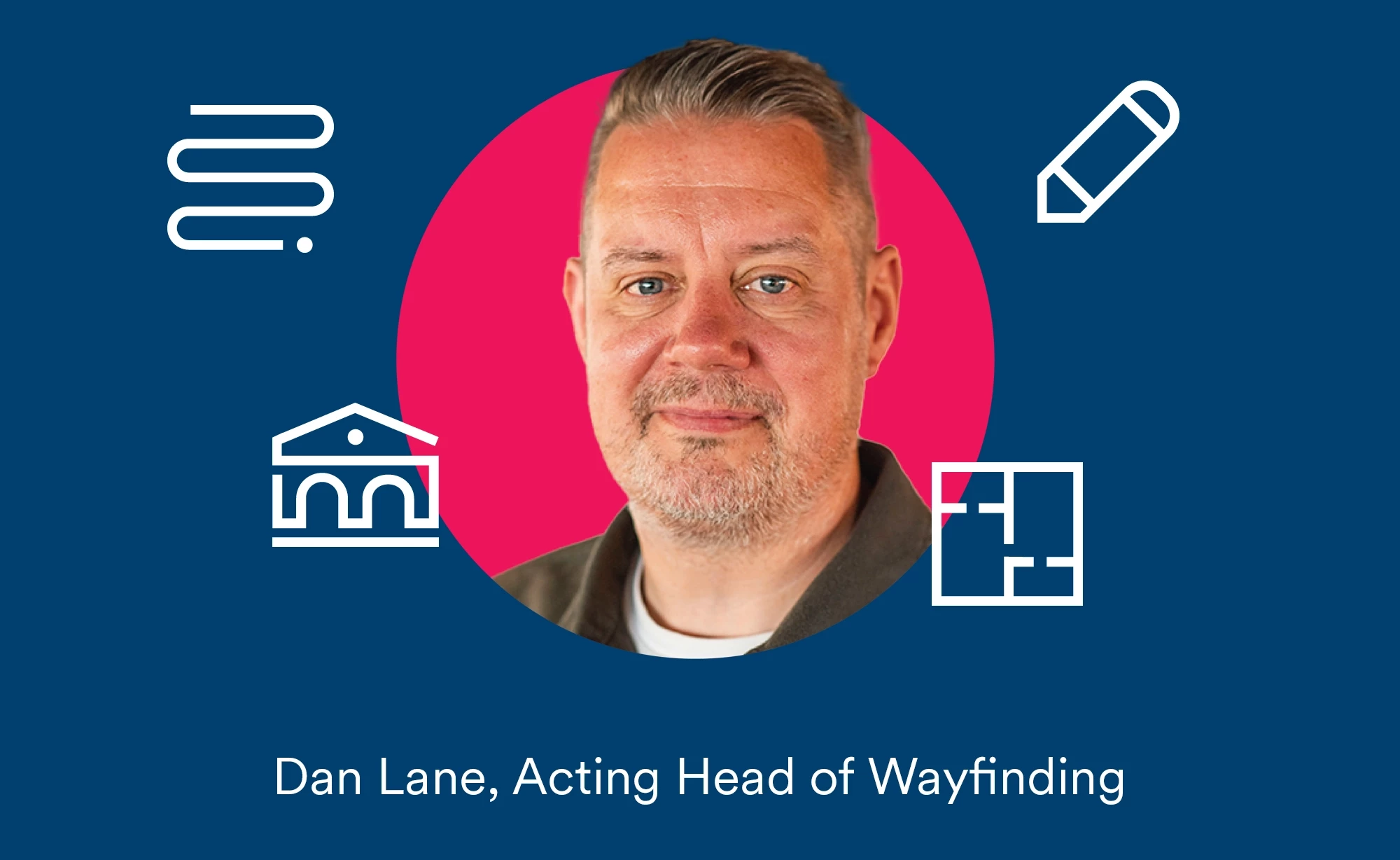Mima Moments - Dan Lane, Acting Head of Wayfinding
We catch up with our Acting Head of Wayfinding, Dan Lane, to discuss what makes a wayfinding system seamless, inspiring navigational murals around Brussels city centre and the vitality of considering wayfinding and signage at the start of the project, not as an afterthought.

What inspired you to pursue a career in design?
I wasn't academic at school but I loved drawing. I used to fill exercise books with drawings of cartoon characters and other things. I still read comics and graphic novels, and I've always enjoyed creating something visual, as opposed to writing. In secondary school, graphic design was offered for one year; I had a taste of it there and I thought this is it, this is what I want to do. That's how it started.
What makes good wayfinding feel effortless?
When the building is well designed, you don't need lots of signs. It should be effortless to navigate a space that is straightforward: how to follow it around, how the flow is determined for different users, and ensuring they don't have to make lots of decisions. This is done by clever architecture. A route can guide visitors around corners and in different directions, but without making them ask questions every minute.
Ikea do it really well. There’s just one direction to travel, one path. They do have a bit of signage but it is more to say, ‘the cafe is here’, ‘lighting is this way’. But you can't get lost, you just follow the route round and that’s really clever.
What defines good user experience?
On big projects with a range of disciplines, wayfinding is sometimes seen as an afterthought. But if you bring us in as early as possible, we can advise and discuss those elements I was just talking about – having an input into the flow of a space so users don’t have to make too many decisions. We can talk about the shape and the route of the building to make it intuitive for people to get around. Say you’re at a museum, you’re there to look at the exhibitions on display. You don't want to have to be thinking ‘Right, how do I get out of this room so I can go and see the next thing?’
Not making people think is the key to a good user experience. Make it seamless.
Not making people think is the key to a good user experience. Make it seamless.
What's an example of wayfinding in the world that most inspires you, what's your favourite, why?
Brussels has about 80 murals around the city. On the side of walls, down alleyways. You can turn a corner and see another mural, it’s beautiful! They speak to me as many are in that famous Belgian cartoon character style. But what it does is act as a guide map for the city. It only takes a couple of times walking past a big Tintin to think, ‘oh yeah I know where I am, I've been here before!’ All these markers are great for you to plot the city in your head and navigate around it. It's a really nice, enlivening method to map out a city for you.
With this in mind, destinations are using markers and visual references to help users navigate, whatever the use of the building. Instead of just having signs everywhere, you could have eye-catching supergraphics or sculpture or planting to help people build a visual imprint in their mind about that space.
What design or innovation trends are you most excited about?
I think we’re still working out the role technology plays. A lot of clients say they want a digital element to their wayfinding, but when you delve deeper into what it might do it can be tricky to find it a permanent role. But I think augmented reality (AR) is really useful and can help people navigate tricky environments. In a hospital, if you can download information ahead of your visit, the AR can work with your phone's map to select the route for you and take you to a precise ward or department. I think that could be so useful in helping people navigate areas where maybe they’re already a bit stressed or anxious, or they haven't been before.
Also, I think we’re seeing a blend now between signage and interior design. It’s not just a sign being put on a wall, there’s a real connection between the sign materials and the treatments and finishes used in the decor of a building or space, they’re both part of the wider interior theme. This relationship enhances that overall design style, and makes the sign system an intrinsic element of the space.
It only takes a couple of times walking past a big Tintin to think, ‘oh yeah I know where I am, I've been here before!’ All these markers are great for you to plot the city in your head and navigate around it.
What does the micro and macro mean to you?
Micro is all about attention to detail. For a venue’s messaging to be easily understood the layout needs to have a homogeneous visual style, and that happens when the same attributes are applied throughout the sign family. Only the same colours, pictograms and type used; everything lined up and spaced precisely. Designers should have phenomenal built-in attention to detail!
The Macro is all about wider consistency. Consider the scheme as a whole, the sign system as one continuous element, and make sure it’s completely consistent in its look and its feel. This is so people can become familiar and take reassurance from it. You want them to think, ‘Okay I've seen some signs that have told me how to get here, I know that I need to look for something similar as I head to the next point in my journey.’ From getting out of their car to arriving at a specific room, users should be spoken to in one continuous visual language.
Many UK hospitals are a collection of buildings of various ages and styles, which are added to the site as the hospital grows over the years. You'll have a Victorian block, a slightly 70s block and a more modern 90s–2000s block. Many hospitals around the country are like this, a collection of differently-aged buildings. But as you transition from one building to another, often the sign style changes and it's all different in appearance and size and colour. You think, ‘Am I in a different place?’ When hospitals build a new annex, I wish they wouldn't just install a new sign system for that one block. We should plan for the site as a whole, and consider how the changes in the signage will impact the visitor. Don't come up with a one off sign system for that one building; either copy what is currently in place elsewhere so users can build familiarity, or come up with a whole new, campus-wide system. It's amazing how many times you go to a destination and the signs change half way around your visit. And by making the sign system consistent and appear as one united element, it reinforces the venue’s brand identity as well.
When hospitals build a new annex, I wish they wouldn't just install a new sign system for that one block. We should plan for the whole site, and consider how the changes in the signage will impact the visitor. Either copy what is currently in place elsewhere so users can build familiarity, or come up with a whole new, campus-wide system.
Written by:

Dan Lane
Head of Wayfinding
Dan is a Graphic & Wayfinding Designer with almost 20 years of commercial experience in the built environment. Covering sectors such as retail, education, healthcare, residential and transport, he is a conceptual thinker who puts the user at the heart of each wayfinding system, with experience working with notable clients including the Royal Opera House, London Stansted Airport, Westfield, and the England football team.